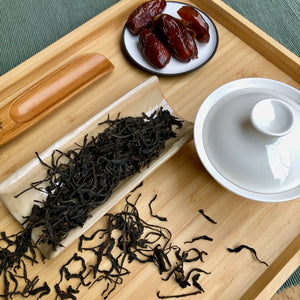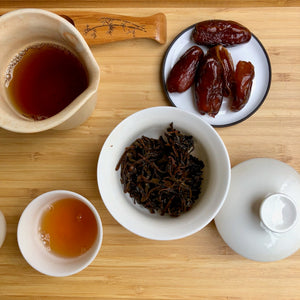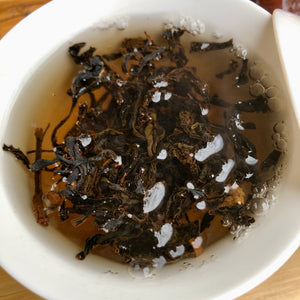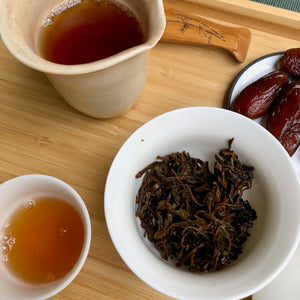
Zheng Shan Xiao Zhong 'wild'
Tax included
Shipping calculated at checkout
In stock
Pickup currently unavailable
Zheng Shan Xiao Zhong 'Wild' 小天小种
A distinctive red tea (hong cha) picked from the wild tea plants of the Wuyi Mountains, bringing the quiet power of nature to your cup. Fresh, sweet and refreshing – with citrus, peach and creamy tones, with a delicate cocoa bean aroma in the background.
Origin & history
The World Heritage Site of Wuyi (Fujian) offers a special microclimate and mineral soils. The adjective “ wild ” here refers to unplanted , semi-wild, abandoned bushes: the plants grow on forest edges, in the corners of bamboo groves, on plots that have long been uncultivated. Pickers return in several rounds and collect the leaves at the best moment – the 2024 picking took place in April .
Taste and aroma profile
- Aroma: delicate cocoa beans, orange peel, pollen sweetness
- Taste: fresh, sweet, creamy citrus-peach character, fresh vibrancy
- Body & texture: medium–fuller, smooth sip, with a silky finish
- Aftertaste: long sweet, fruity-creamy aftertaste
Preparation
Our initial recommendation – adjust it to your own taste.
- Water: low mineral content (< 250 mg/L), 90–95 °C
- Dosage: 5–6 g leaves / 150–200 ml water
- Soaking: 1st pour ~1 minute, then increase the time for each subsequent pour.
Gongfu (multiple short casts)
- Dosage: 4–5 g / 100–120 ml
- Water: 90–95 °C
- Times: 15–20 sec → 20–25 sec → 30–40 sec → further pours with gradual increase
“Western” method
- Dosage: 2.5–3 g / 250 ml
- Water: 90–95 °C
- Time: 2.5–3.5 minutes (longer for a fuller cup)
Tip: if you want a cleaner, more “citrusy” image, shorten the pours; if you’re looking for a creamier side, leave it on longer or increase the amount.
Why is it special?
- Wild (semi-wild) bushes: rarer, more complex aromatics
- Rich yet fresh character: excellent breakfast and “starter” tea
- Long-lasting experience : holds up well to multiple pours, doesn't fall apart

Personal contact
Our teas don't come from wholesale warehouses or unknown sources. We travel to the small producers we source from – whether it's a Japanese family tea garden, a Chinese mountain village or an oolong maker in Taiwan.
Stories
We meet them in person, learn their story, see how they care for their plants, and how they process the fresh leaves.
These experiences are the soul of our teas. This way, not only is the quality guaranteed, but also the fact that behind each cup there is a real person, a real story.


Direct
This direct relationship is valuable to us. Not only because of the excellent tea, but because we believe that trust, respect and personal presence are what make the tea drinking experience truly special.
Teavolution Tea Blog
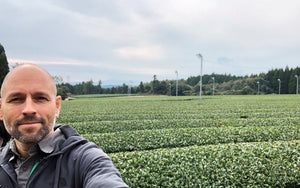
Oct 2, 2025
Sencha tea
Read more

Sep 21, 2025
Matcha hiány Japánban
Read more
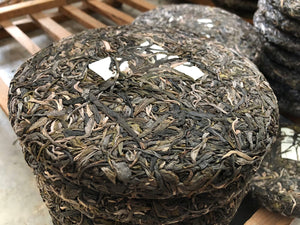
Mar 18, 2025
Puer tea, puerh or pu-erh
Read more
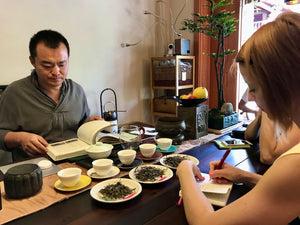
Mar 18, 2025
Types of tea
Read more
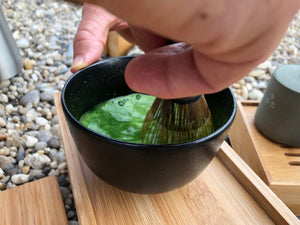
Mar 18, 2025
What is matcha tea?
Read more

Mar 18, 2025
Oolong tea (Wulong tea)
Read more

